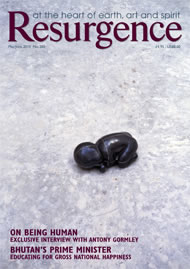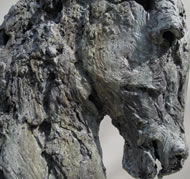The rocky walls that frame artist Andrew Lacey’s South Devon workshop seem to reflect back its occupant’s sculptural intents. Tucked into a corner close to the rock face, here, the trees and birdsong soften the sound of hammers and there is a sense of rightness in the open-air firing of crucibles of liquid bronze.
A corrugated roof covers the area by the workshop where the crucibles are heated, where bronze is poured into moulds and where, at dusk, pipistrelle and lesser horseshoe bats flit around, picking off insects. There is an accord here between an ancient form of manufacture – sculptures cast in bronze – and the trees, the brook, the pond and the flora and fauna. And it is an accord Devon artist, Andrew Lacey, his partner Siân Lewis and his brother Robin (who both share the studio) are quietly determined to deepen.
It’s very rare to find someone like Andrew who is an artist, a historian and an artisan for other artists and who moves, apparently seamlessly, between these areas, whilst also running a busy workshop and studio. His expertise in bronze has led to consultations for the Victoria and Albert Museum in London and the Fitzwilliam Museum in Cambridge and he has even appeared on the popular UK television series Time Team. Andrew’s own work is inevitably fed by his knowledge of history and, of course, his particular knowledge of bronze. He has examined and handled ancient and classical bronzes, and that closeness, he says, is what has allowed him to understand the hands of those early sculptors.
By studying a material in such detail, an artist becomes a constant student of its chemistry and its behaviour. Potters, for instance, come to understand the particular clay they use and how it behaves as it dries, shrinks and fires. As a sculptor, Andrew is unusual in that he understands the archaeology of bronze and the ancient techniques. This in-depth knowledge gives him the edge on the artists who come to him and present their work for casting and also means he knows not only how to sympathetically interpret their work, but how they themselves would like it expressed in the casting and patination.
His own art is concerned with the human figure and with horses and their riders. None of his pieces are of complete forms but are studies which, through their vitality, imply the rest of their structures. It is as if they had been dug out of the sand or dredged from the sea. Only their forcefulness makes their contemporary origin inevitable. All his drawings and sculptures are concerned with what lies beneath the surface of their subjects. Flesh is implied through a quick line or a shadow but his search is beneath the skin into a world of bone, tendon and muscle. This concern for underlying form is incisive; a reminder of the essential structure provided by our skeletons.
In his busy schedule, Andrew is determinedly greening his workshop practices, delving into history for ancient methods that can leave bronze casting more free of environmental costs. The earliest tin alloy bronzes were made in the late fourth millennium BCE in Iran and Iraq. Copper is the main constituent of bronze and the earliest makers of bronze had to trade the constituent metals because they rarely occur in the Earth together. Their methods of making and casting made good use of locally available materials. But bronze-making, like so many other ‘industrial’ activities, has gradually accumulated processing and habits that use unsustainable materials and methods.
The challenge that Andrew and his team have now set themselves is to reduce that accumulation and rethink the current use of materials, replacing them with naturally occurring and recycled substitutes. All of the bronze used at the workshop is recycled from copper wire and industrial waste. For the final patination, they use fruit and vegetable acids rather than laboratory chemicals. Potato replaces finishing polish compounds, and mineral salts replace laboratory chemicals. In the mould-making, plaster and gelatine are replacing silicon rubber; plant fibre is replacing glass fibre, as are animal hair and wool. Sand, ash and charcoal dust are replacing molochite-fused grain. Ultimately the fuels used will be wood, charcoal and vegetable oil rather than gas, coal or electricity.
The prerequisite for selecting each new material is that it must adequately replace the physical quality of the former material in each process and not produce any significantly negative by-products. Also, that it should be produced or collected locally. For example, beeswax can replace microcrystalline and paraffin wax, amber rosin from pine trees can replace petrochemical materials, turpentine from larch trees can replace petrochemical solvents, and vegetable oils can replace petroleum jelly. Andrew has made a careful audit of his materials and processes and is now well on the way to completely replacing all those which are unsustainable.
The artists here are also changing back to re-use more hand tools in finishing the bronzes. Thus out go grinders and electric sanders for tools that take a little longer but give much more sense of control and are much more pleasant to use. The atmosphere in the finishing workshop is reflective, busy and productive. There is a fascinating mixture of pieces being made for other artists amongst examples of Andrew’s own work. There is also a litter of inspirational objects, archaeological treasures, and vigorous drawings on scraps of card and paper.
It is clear that, despite its tucked-away location, the workshop houses a complex juggling act. Demanding artists call by to bring pieces to be cast, bronze pours take place, students stop by and plans need to be made for the next teaching assignment and the next piece of research. In the midst of all this, a sustainable model is being developed which uses medieval and Renaissance principles. Andrew is keen to point out that all he needs to achieve these principles is recorded in old texts and it strikes me that this is true of many other craft-based industries.
The fine statues made by Hindu artisans of the Chola Empire in Tamil Nadu using lost-wax casting to depict their gods embodied a skill still practised in India today by craftspeople working in Swamimalai and Chennai. The bronzes made in the Kingdom of Benin are also examples of the highest skill and artistry using low-tech means. As Andrew Lacey’s workshop is quietly revealing, we do not need to be beholden to materials based on petrochemicals and diminishing energy resources.
Out of this ancient South Devon quarry a methodology is emerging which challenges conventions. Here industry and art are engaged deeply in the thoughts of a trio of makers who are determined to move forward with their work in a way that causes the least environmental impact. There is still further to go in the greening of their processes but there is an uncommon sense of balance in this working atmosphere, and what their commitment shows is that it is quite possible to question the rationale of the industrialised world and to find alternatives to common practice.
To see more of Andrew Lacey’s work, visit www.andrewlacey.com








